
Protopresbiter John Meyendorf about the book "Tragedy of the Russian Church"
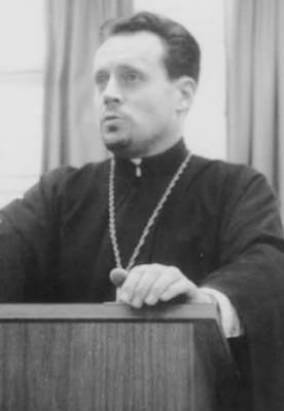
Fr. John Meyendorff. Professor of Church History and Patristics at St Vladimir's Seminary, 1959.
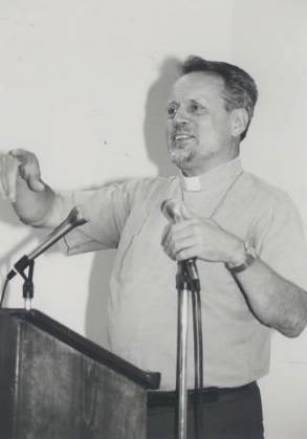
Fr. John Meyendorff. Professor of Byzantine History at Fordham University, from 1967.
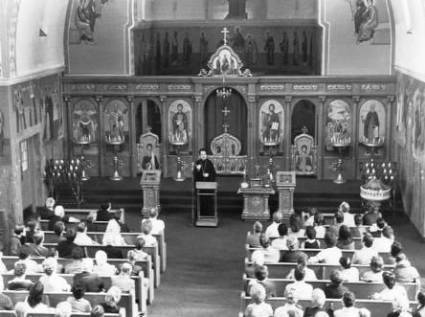
Decan of St.Vladimir's Seminary 1984-1992
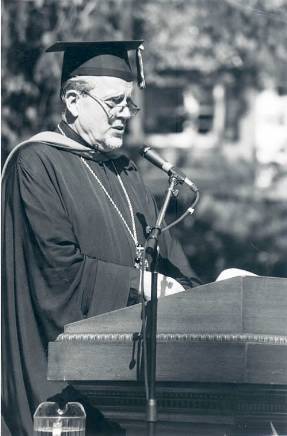
Fr. John Meyendorff. Honorary Doctor from the University of Notre Dame
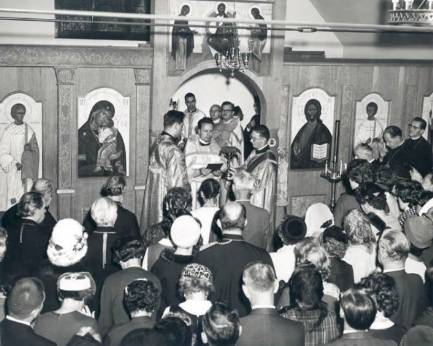
Fr. John Meyendorff performs the Liturgy
The author of the present book belongs to the young generation of the Russian intelligentsia. He and his contemporaries came to the Orthodox Church trough conscious conversion to Christ, although in upbringing they belong to Soviet society, where religion has been being eradicated for almost sixty years now.
It is most significant that this first - in Russian - attempt to write an outline history of the Russian Orthodox Church in the terrible years of persecution in the twenties and thirties has appeared now in Russia, although the author cannot, of course, publish his work in his country.
The religious renaissance among the young intelligentsia cannot avoid such questions as: into what kind of Church are they being converted?
What is the nature of Russian Orthodoxy today?
What is the place on the Church in the tragic history of the revolution and its consequences?
Are the accusations made by anti-religious propaganda right in saying that in their non-acceptance of Marxism the Orthodox clergy were guided only by mercenary interests and the dream of a political restoration of the monarchy?
Is it true that while nothing "official", particularly official propaganda, is trusted by the intelligentsia today, the question of why the organs of the Church itself, i.e. the Moscow Patriarchate, confirm the state version of events and deny that religion is persecuted, although the closing of churches and discrimination against Christians, the incredibly heavy taxes on both parishes and clergy are easily observed facts of Soviet life, cannot be ignored. And consequently, if the official version of the position of the Church is false, is it not time to reinstate the truth and, in particular, to resurrect the memory and cult of the martyrs?
However, all these questions can be answered only after the historical facts of the last few decades have been restored and made accessible to the public at large. Just as without restoring the memory of the "Archipelago" Russia cannot revive its conscience, so Orthodoxy cannot build the future without the memory of the past and, in particular, without the memory of its martyrs, on whose bodies the Christians of the early church celebrated the Eucharist and thanks to whose blood the Russian Church is alive today. Lev Regelson's attempt to collect material about the events and people responsible for the life of the Church in the transition period between the Revolution and the Second World war is not only historic work, but also a most timely manifestation of loyally to all that is honest, pure and sacred in the life of the Church.
The author had access to private archives and correspondence and made use of memoirs and unpublished manuscripts, of which one of the most important was six-volume dictionary of Russian bishops of this period compiled by Metropolitan Manuil (Lemeshevsky) of Kuibyshev before his death in 1969. This does not mean, of course, that all Lev Regelson's conclusions can be regarded as final. Undoubtedly there are a large number of documents to which he did not have access. At the present time it is impossible to even raise the question of a "normal" study of the most recent period in the history of the Russian Church. One can only dream of continuing the "underground" private collection of information begun by the author. Only gradually will the characters, the circumstances, the transgressions, and also the truly Divine miracles become known and the general historical picture begin to emerge. Lev Regelson's heroic work will undoubtedly serve as the foundation of the historiography of the Russian Church of the modern period, but it requires continuers.
Among the material not used by the author are several foreign editions.
L.Regelson had access to only some of them: Archpriest M.Polsky's book on "The New Martyrs", Metropolitan Eulogy's "My Life's Path" and others. But lie did not have access to books published in German, English and French. Many of these foreign editions are of inestimable value for clarifying the church policy of Patriarch Tikhon and Sergius as locum tenens. I have in mind, for example, the book by the Catholic priest-monk Chrysostomus: Kirchengeschichte Russland der neuesten Zeit. Freiburg. 1968 (Priest-Monk Clirysostomus himself took part in and witnessed church life in Russia in the 1920s and 1930s); William C, Fletcher: A study in survival. The Church in Russia. 1927-1943. London. SPCK. 1965; Harvey Fireside: Icon and Swastika. The Russian Orthodox Church under Nazi and Soviet Control. Cambridge. Mass. Harvard University Press, 1971 and many others. Although these authors did not have access to the sources used by Regelson and, of course, did not have the personal (and therefore indispensable) experience of a contemporary participant in church life in Russia, nevertheless their works contain facts and assessments which add significantly to the material collected by Regelson. Of the important Russian foreign editions the author was unfamiliar with T.V. Troitsky's book: What is the Living Church? Warsaw, 1928 with its excellent assessment of Renovationism as a kind of revolt by the White clergy against the episcopate, and the memoirs of a former colleague of Patriarch Tikhon and Metropolitan Sergius, Protopresbyter Vasily Vinogradov: On some most important aspects in the activity of the last period of the life of Patriarch Tikhon. Munich, 1959. (Priest-Monk V.Vinogradov was a member of the Supreme Church Council under Patriarch Tikhon in 1924).
Whereas these editions can supplement the content of Regelson's book, however, the latter provides a canvas within the framework of which individual events and materials described in other sources fit and itself contains a vast number of hitherto unknown facts and documents. One may disagree in individual cases with the author's criteria and "spiritual style" in selecting facts. Was it, for example, really necessary to include the visions of the Virgin Mary in Fatima in the list of "dates and documents" of the history of the Russian Church? (This information is omitted in the present edition - L.R.).
However, it is not the book's "spiritual style" that its main interest, but the author's general conception, which is of tremendous importance in assessing not only the events inside Russia, but also the Russian church formations abroad.
The following tenets seem to us to be most important for an understanding of Regelson's historical conception:
I. His history is primarily a history of the Russian episcopate in the post-revolutionary period: the book contains very little information about the life and views of the ordinary clergy and parish communities and about their attitude to the bishops who were disputing among themselves or to the different trends in the patriarchal Church and Renovationism. The meaning of the amazing fact that it was the people who managed to preserve true Orthodoxy, reject the falsity of the Renovationist schism and "withstand" the onslaught of state attempts to destroy the Church remains a task for future historians.
We do not reproach the author for his interest in the episcopate in the post-revolutionary period. As an Orthodox historian, he understand that without the episcopate there can be no Orthodoxy, 'no church, and he rightly believe that the history of the episcopate should serve as the basis for Russian church historiography of the new period. But the history of the Russian episcopate in the twenties and thirties presupposes that questions of a canonical nature are the central ones: the episcopate preserve the continuity of church life and church teaching; it is called upon to observe the unity of the Church; it is responsible for the Church as a whole - for its structure, its mission and the life of each church community. Soviet power sought to abolish all these structures and agreed to a temporary compromise with the Church only to lie extent that the Church continued to enjoy popular support. Yet at the same time the authorities tried to use hierarchical structure of the Orthodox Church in order to control it "from the top" (i.e. through the episcopate itself) to divide it (exploiting canonical and personal disagreements between the bishops) and, finally, to bring about its inner collapse.
The main question for the leaders of the Church was the following one: should they or should they not try to preserve the centralized structure of the Church under the administration of the patriarch (although after the death of Patriarch Tikhon in 1925 the authorities did not permit the election of a new patriarch)? To agree to the abolition of the patriarchal center meant handing over the monopoly of a "legalized" church to the Renovationist "Synod" (recognized by the Eastern Patriarchs !!!), which would gradually have acquired the use of all open churches. However, preserving patriarchal administration presupposed state control. A strange choice faced the conscience of Locum tenens Sergius, who (after long vacillation) chose the path of cooperation with the authorities for the sake of preserving the continuity of "lawful" Orthodox.
Lev Regelson believes that this choice by the Locum tenens was wrong. In his opinion, the Locum tenens should not even be given credit for the restoration of church life by Stalin during the Second World war: Stalin allowed the election of a patriarch and the opening of churches not because Sergius' Synod was a ready (and obedient) instrument of this restoration, but because the people and world public opinion demanded it. If patriarchal rule had not existed in 1943, Stalin would have summoned the various groups of clergy and believers' out of the underground and restored patriarchal rule all the same, which would have had more inner freedom and moral purity than Sergius' rule.
2. The author bases his canonical and historical assessments on the Decree of Patriarch Tikhon issued on 7/20 November, 1920, i.e. still during the Civil War. The decree admitted the possibility of the temporarily independent existence of dioceses (or groups of dioceses) in the event of the separation from the patriarchal center or the termination of the activity of the Supreme Church Administration. The author sees this Decree as a return to the old church structure, where there was indeed no concept of the subordination of bishops and their dioceses to any "supreme power". The Council of 1917-1918, by restoring the election of archbishops by dioceses, also in part restored this old structure, in which the author rightly sees the foundation of the Orthodox interpretation of the Church as it was expressed in the pre-Constantine period, when the Church had no connection with the state. The gradual historical formation of "metropolises", "archbishoprics" and "patriarchates" (in the 4th-5th centuries) was not aimed at changing the original structure of the Church as a unity of faith between local communities led by their bishops, but simply expressed the need for organized unity in new historical conditions. The "subordination" of local bishops to metropolitans and patriarchs was not an aim in itself, but only a means conditioned by sobornost , i.e., the subordination of the metropolitan or patriarch himself to the soborny judgement of the bishops and the Church as a whole.
Patriarch Tikhon's Decree of 1920 admitted the possibility of the abolition of patriarchal rule and indicated how, in that case, the Church was to return to the conditions which existed in the age of persecution during the first few centuries of Christianity.
Regelson takes the view - and this is the leitmotif of his work - that Metropolitan Sergius, who ran the patriarchal administration after the locum tenens Metropolitan Peter of Krutitsky was exiled (December 1925), made the mistake of not following the Decree of 1920 and of directing all Ins energy and intellect towards preserving the "center" to winch the bishops were to "subordinate themselves." The error of his path (in the author's view) was that in Soviet conditions the "center" could only be preserved by "coordinating" its activity with the authorities, i.e. by in effect permitting the control of the authorities over the activity of the "center".
We shall return to this main thesis of Regelson's below, but it must be said here that the author recognizes not only the psychological lack of readiness of the Russian episcopate for the principle of "the independent existence of dioceses", but also that Patriarch Tikhon himself in his Decree permitted this independence only "up to the organization of the Supreme Church Authority", retaining for the latter the right to approve or not approve resolutions adopted during the temporary "independence" of dioceses. Consequently, Metropolitan Sergius' efforts to preserve the "center" were in keeping with the inner strivings of the Russian hierarchy and the Patriarch himself. But the question of whether or not these efforts were right in essence and in the method which Metropolitan Sergius used must, of course, remain open.
Regelson's book contains much historical information about the attempts made by several Russian churchmen to set up temporary "autocephalia" in keeping with the Decree of 1920. The most important of them were Metropolitan Agathangel of Yaroslavl and Metropolitan Cyril of Kazan. It should be remembered that in 1924 the North American diocese proclaimed itself "temporarily self-governing" on the basis of the Decree of 1920. In any case, several "autocephalia" arose in the twenties and thirties.
Some of them had somewhat ambivalent relations with the Renovationist "Supreme Church Administration" set up in 1922: thus, Metropolitan Alexis (Simansky) of Yamburg who administered the Petrograd diocese, the future Patriarch, together with another Petrograd vicar, Bishop Nicholas (Yarushevich) of Peterhof, also set up an "autocephalia" in 1922, winch was described in detail by A.Levitin in his history of Renovationism. On 9 June, 1922 Bishop Alexis removed the ban from Vvedensky and boasted that his administration of the diocese had received the "consent" of the Renovationist Supreme Church Administration. Lev Regelson is not quite right in accusing bishops Alexis and Nicholas of outright acceptance of Renovationism. Bishop Alexis limited himself - and that for a very short time - to semi-acceptance of the Renovationist Administration, but already two weeks later (on 24 June, 1922) refused to cooperate directly with the Supreme Church Administration and was exiled as a result. Information and documents concerning these events were published by Archbishop Sergius (Larin) in the "Vestnik Russkogo Zapadno-Yevropeiskogo Patriarshego Ekzarkhata" Nos. 45-48, 1964. The author was not aware of this publication.
The case of Metropolitan Sergius (Stragorodsky) is quite a different matter. The open acceptance of Renovationism by this eminent theologian and churchman played a fatal role in the tragic months of 1922. True, his solemn repentance in 1923 before Patriarch Tikhon was also not lacking in immense spiritual significance.
3. The personality of Metropolitan Sergius and his activity are at the centre of all the church events of the twenties and thirties. Decisive non-acceptance and criticism of this activity is the main thesis of Regelson's book. In the author's opinion, the authority of the "Deputy to the locum tenens", and then simply "locum tenens" Metropolitan Sergius was, on the one hand, void of indisputable canonical legality and, on the other, presupposed a morally unacceptable servility to the authorities.
Such an assessment of Metropolitan Sergius' activity coincides for the most part with the standpoint of those church leaders who, although in opposition to the "locum tenens" in the thirties, recognized as legitimate the election of Patriarch Alexis by the Council of 1945 and entered into contact with him. The most authoritative and outstanding churchman in this group was Bishop Athanasius (Sakharov) about whose confessorial life the book has much to say.
The question of the legitimacy of illegitimacy of the heading of the Russian Church by Metropolitan Sergius is connected, firstly, with the actual system of appointing a locum tenens while the Patriarch himself is still alive, which was introduced by Patriarch Tikhon at the request of the Council of 1917-1918.
This system has no precedent in the history of the Church and directly contradicts the canons, which forbid bishops (and even more so patriarchs) to appoint their own successors: a bishop is always God's elect through the Church and cannot be appointed by any single person. In justification of the Patriarch's action it can only be said that the conditions in winch the Russian Church found itself were entirely unprecedented and, as Regelson rightly points out, the Patriarch was acting in accordance with the Council's instruction, and not on some personal whim. True, the "locum tenentes" designated in his will in 1925 were probably already not those whom he appointed at the closed meeting of the Council in 1918. Of the Patriarch's three appointees in 1925 - metropolitans Cyril of Kazan, Agathangel of Yaroslavl and Peter of Krutitsky, only the last was at liberty. His "locum tenens" became the only universally (in Russia and abroad) accepted symbol of the unity of the Church after Patriarch Tikhon's death.
Even more disputable are the subsequent appointments of "locum tenentes". Metropolitan Peter made two appointments of "locum tenentes": while still in power he appointed Metropolitan Sergius (Stragorodsky), Michael (Ermakov) and Joseph (Petrovykh) and after his arrest a deputy "collegia" with Archbishop Gregory (Yatskovsky) at its head. Metropolitan Joseph (the future head of the "Josephians"), who took over the management of the Church after the arrest of Metropolitan Sergius in 1926, appointed up to ten possible locum tenentes... The statement - withdrawn almost immediately - by Metropolitan Agathangel in 1926 that he was assuming the powers which he had received from Patriarch Tikhon himself complicated the question of leadership of the Church even more. There can be no doubt, as Regelson frequently admits, that the chaos over tlie "locum tenens" was deliberately fuelled by the authorities, who encouraged the Renovationists, the "Gregorians" and Metropolitan Agathangel himself to declare their "rights" to it.
Therefore, if Metropolitan Sergius' "rights" were undoubtedly questionable, the claims of all his rivals were even more so, Regelson's conception, which we have already mentioned above and according to which the best solution for the church leadership would have been decentralization, in accordance with the Decree of 1920, does not seem entirely convincing to us either. In any case, as the author himself admits, the Russian episcopate was not psychologically prepared for this: it was too accustomed to the centralized routine of Synodal government, and the election of the Patriarch in 1918 was seen as the acquisition of a charismatic leader of the Church, without whom church life seemed impossible. Regelson himself stresses the importance of "Patriarchal charisma" for the church consciousness of believers. Finally, the existence of the Renovationist "Synod" and the Gregorian "Provisional Supreme Church Council" demanded the creation of a provisional Center from canonical Orthodoxy as well, if only for representation and testimony to the illegitimacy of the schismatic "centers". We also think it obvious that of all the Russian hierarchs of this period Metropolitan Sergius was the most capable of understanding the tragic complexity of the situation.
Metropolitan Peter, Agathangel, Joseph and other possible "locum tenens" showed neither consistency nor logic in their actions and appointments. Metropolitan Sergius' consent in principle in 1926 to recognize the freedom of dioceses abroad to determine their own path independently of Moscow and particularly his unsuccessful attempt, also in 1926 (about which Regelson provides a great deal of new information and for which Metropolitan Sergius himself was arrested) to elect Metropolitan Cyril as Patriarch by means of a secret ballot of the episcopate in writing without the knowledge of the authorities show that before "deciding to compromise" he actively and even most adroitly tried to find most advantageous solution for the Church. Metropolitan Sergius "adroitness" manifested itself again in 1941, when his Exarch in the Baltic, Metropolitan Sergius "junior" (Voskresensky) remained in the occupied territories and led a rebirth of the Church under the Germans. Metropolitan Sergius (Voskresensky) was killed by the Gestapo (or Soviet partisans?) in 1944, when he was already preparing a "return" to Soviet conditions. It is hard to believe that this was done without the knowledge of Sergius (senior). The activity of Sergius "junior" was hardly known to Regelson, and his descriptions published abroad of conditions of work in the Moscow Synod in the 1930s, in which Metropolitan Sergius (Voskresensky) played an active part, arc also very important for a final historical assessment of the role of the locum tenens in the life of the Russian Church.
Of course, a high price had to be paid for the "legalization" of Sergius' Synod in 1927, first and foremost, in statements that there was no persecution of the Church in the USSR. This essentially pointless lie which did not convince anyone, and also the direct dependence of the "legalized" church administration on state "officials", was what aroused the opposition of the so-called "non-rememberers" (nepominayushiye) among whom there were also some eminent hierarchs of the Tikhon period.
Here too, however, the impartial historian must admit that even Patriarch Tikhon himself was accused of excessive compliance and that the nucleus of the future anti-Sergian opposition was already in opposition to Patriarch Tikhon himself (the "Danilov group"). In any case the Patriarch himself thought it possible to make a statement in 1923 to the effect that "Soviet power must not be accused to persecuting any religion". Metropolitan Sergius could refer to this precedent.
Whatever one thinks of the Patriarch's conciliatory and "loyal" policy in the last two years of his office, the name of His Holiness Tikhon was already accepted by the Church and the popular consciousness as the name of a great confessor of the faith. The locum tenens and later Patriarch Sergius did not have such authority, and the opposition to him became more open. In any case the criticism of him in Lev Regelson's books undoubtedly deserves far more attention than everything that has been written and said about him abroad. But we feel that Regelson has not said the final word about him either.
One aspect of the locum tenens' activity is subjected to particularly sharp and justified criticism in the present book: this is the ease with which Sergius' Synod used canonical sanctions and bans against people of different views, both inside Russia and abroad. Metropolitan Sergius may have been trying through these sanctions imposed on those who challenged his authority to strengthen his own, by no means indisputable position, to show urbi et orbi, that he was the head of the only true Church. However, these bans imposed without trial or investigation resulted in one thing only: a deepening of divisions and reciprocal accusations by the extreme opposition of the "lack of blessedness" of Sergius church. True, it was not Metropolitan Sergius who began the policy of peremptory banning. This was begun by the Renovationists who "deprived" Patriarch Tikhon of his office and continued by the "Gregorians". By taking over this practice of the schismatics, Metropolitan Sergius revived the worst, and by no means "Tikhonian", features of the old bureaucratic centralism.
Regelson is quite right in describing this aspect of Metropolitan Sergius's policy as "blasphemy of grace" and equating his dispute with Metropolitan Agathangel with the conflict between the Karlovtzy Synod and Metropolitan Eulogy. In both cases, the author believes, the hierarch who had indisputable authority from Patriarch Tikhon was defending his responsibility for the Church against the claims of a self-appointed and arbitrarily chosen group of bishops. In our opinion, there is a parallel between these two cases, but there are also differences: Metropolitan Sergius was the ruling metropolitan of Nizhne-Novgorod, the officially recognized locum tenens and the head of the Synod of canonical bishops.
The Karlovtzy Synod, however, which consisted of bishops who had abandoned their dioceses and were acting on the territory of another autocephalous church (that of Serbia) and which had formally been deprived of all canonical validity by the Patriarch's direct Decree in 1922, was committing a greater "blasphemy of grace" than Metropolitan Sergius in "banning" metropolitans Eulogy of Western Europe and Platon of North America, who had been lawfully appointed by Patriarch Tikhon, From the purely canonical point of view, the "Karlovtsians" were "pretenders" to a greater extent than locum tenens Sergius, and they alone, acting with complete freedom, out of the reach of Soviet power, held a sad monopoly on ex-communications and bans abroad. Metropolitan Eulogy and Platon, as well as metropolitans Agathangel and Cyril, about whom Regelson writes in detail, refrained from anathemas and, even scorning canonical principles for the sake of peace and harmony, frequently entered into temporary practical brotherly agreements with the Karlovtzians, while preserving the principle of their own independence.
Referring to Metropolitan Sergius' highly one-sided book "The Truth about Religion in Russia", Lev Regelson mentions a "union of Theophilites (North American Church) with Karlovtzians" supposed to have taken place in 1935. In fact what really happened was merely the acceptance of a "provisional position" in which the American Church preserved its full independence. It is also incorrect that Metropolitan Eulogy signed a declaration of "loyalty" in 1927. In fact, for the sake of preserving canonical communion with the Russian Church. Metropolitan Evlogy gave (in assurance only of his own "a-politicalness". Repeated demands about "loyalty" led to his rupture with Met. Sergius in 1931.
Throughout his whole work the author does not conceal his sympathy for the anti-Sergius opposition of the twenties and thirties and the vestiges of the "non-rememberers" which still existed in the sixties. The position of the latter is set out well and at length in an anonymous letter written in 1962 and quoted in the book in full. It shows clearly that today the "non-rememberers" movement exists only in "cells" and that for the many millions of believers in Russia there is no possibility of going to any churches except patriarchal ones. And the "non-rememberer" writer of the letter in no way condemns those who do so.
In general, the fact that Regelson's book is a truly Orthodox one can be seen from the fact that it is entirely based on belief in the unity of the Church and the unity of Christ's grace: the dispute between Metropolitan Sergius and the "opposition" is a dispute inside the Church. One can and should challenge the correctness of the behavior of certain hierarchs of the Church, but there is still no other Church apart from the one which they head. Just as the Orthodox consciousness cannot help regarding certain actions by Patriarch Nikon and, in particular, the court hierarchs of the age of Peter I as mistaken and even blasphemous, but the sacraments and continuity of the Church were not damaged by their sin!
The main strength of Regelson's books lies in its just protest against reducing Orthodoxy and Orthodox canons to the concept of "subordination". Both the right and the duty to "judge" and "distinguish spirits" belong to all God's people, and the bishops in particular. Without the possibility of judging the meaning and correctness of "the decrees of supreme power" there is no Orthodox sobornost. But the author is also right in saying that "retaining the right to judge the actions of the church authority should not mean a severance of canonical and liturgical communion with it." It is on this basis that he accepts as correct the position of those "non-rememberers" who recognized the Moscow Patriarchate restored at the Council of 1945, in spite of the glaring canonical imperfections of the restored church structure.
This faith in the Church is the main strength of the book, which may not satisfy either the rigorists of the "canonicity" of the Moscow Patriarchate or the new Donatists who dream of a Church of "the pure" and leave out historical reality and responsibility for the souls of "those of little strength". This strength is in the words of Our Savior:
"Upon this rock I will build my church, and the gates of hell shall not prevail against it" (Mt. 16:18).
Protopresbyter John Meyendorff
Saint Vladimir Theological Seminary
 New York 1977
New York 1977